Scotts Steering Stabilizer
Company: Scotts
Price: $449.95 and up.
- One of the most sure-fire handling improvements to any bike.
- Super adjustable to accommodate any rider's taste.
- Durable and almost forgettable once set up on the bike...Till you ride without it.
- Excellent instructions.
- Takes up room on the handlebar/crossbar area.
- Sometimes requires re-thinking handlebar position with different clamps.
What it is
- A hydraulic damper that stabilizes your steering.
The Scotts Steering Stabilizer is a hydraulic damper that mounts on the center of your steering head and through its arm attaches to the frame. It uses a vein passing through an oil filled chamber to dampen the sweep of the handlebars. The unit is adjustable in low-speed damping, high-speed damping and in degrees of sweep with damping resistance. Specific to the off-road units, the damper has no valving in play when returning back to the center position.
The stabilizer is mounted to the bike through a specialized mounting kit that varies by machine and bar position setup on the bike. Low-speed adjustment is through a knob atop the unit and can be done on the fly. High-speed and sweep adjustments are accomplished with a flat screwdriver. The unit is rebuildable and serviceable.
It is claimed that by helping to stabilize the front end of your motorcycle, the rear of the motorcycle will track straighter allowing the rest of your suspension to work the way it was designed to. Additionally it can take the jerk or jolt out of the bars when hitting objects that want to deflect the front end and eliminate headshake.
How it works
- Bolts on with excellent instructions.
- Does exactly what it was designed to do-- dampens the steering as much or as little as you'd like.
- Extremely (and independently) adjustable in three critical areas.
Bolting on the Scott's Steering Stabilizer and its kit is about as difficult as greasing your headset bearings--and a really good time to grease your headset bearings since your top triple clamp usually has to be removed. For most bikes it is about a 1-2 hour job and properly setting the mount onto the frame is critical to get a good sung and tight fit. The instructions are usually step-by-step and will point out any things you need to take care with, pictures included. Setting the stabilizer is, for the most part, already done for you as most riders will not need to alter either the high-speed damping or the sweep from the as delivered setting. The instruction manual for the damper is very detailed and clearly explains the different functions and how to adjust them if you feel the need.
Since mount kits and variations differ so much, this test will concentrate on the performance of the damper as we have used it on many different bikes. We have never come across a bike that did not benefit from the damper but some bikes more than others.
Depending upon how you set the low-speed adjustment will determine how much you will feel the damper through your steering. You can set it stiff enough that it is actually difficult to turn the handlebars which will make it hard to keep your balance. You can also back it off close to two to three full rotations (eight clicks per rotation) so that you don’t feel much damping at all. Yet in riding there is always some effect in the stability of the bike. Even with the low-speed backed way out, the high-speed is kicking in and you can’t actually “feel” it other than the more stable and solid front end feeling. Setting the low-speed is a very personal preference. In loose sand or even in muddy conditions most riders liked a stiffer low-speed setting. Conversely in tight trees or on tracks with a lot of steering inputs less low-speed damping was preferred. Typically, higher skill level riders usually liked less low-speed damping than more novice riders. In practice you can set the damper so the bars resist moving as little or as much as a rider wants but it also will affect how much effort you’ll have to put into them to get them to move away from center.
One of the best features of the Scott's is the adjustable high-speed circuit. It can be set to kick in at different levels or speeds of turning the handlebars. Its tuning is completely separate from the low-speed circuit, which keeps it simple to set up should you feel the need. It typically kicks in on a sharp or abrupt hit, like when catching a rock or on a cross root that tries to take the handlebars out of your hand. And it is like magic when you do hit something and the bike continues straight and the bars not trying to jerk from your hands. As little as 1/16th of a turn is noticeable to when the damper’s resistance kicks in and how hard it kicks in. You definitely don’t want the high-speed to kick in at a speed you will turn the handlebars as you will fight it. Having too little high-speed damping basically takes away one of the best features of the stabilizer.
The sweep settings are also a pretty valuable adjustment. Once a rider figures out a setting it can typically be left alone. The side-mounted valves basically adjust where the damping stops as the handlebar is turned away from center and then there is no damping. So if you are making really tight turns where the bars are turned more near the steering stops, there is no damping. Usually this is a very slow speed maneuvering and requires a lot of quick inputs so not having damping here is a great feature. For the most part we left them in the standard setting but on some occasions (like going from motocross to tight woods riding) a rider might want to change this.
The one thing that made the Scott's Stabilizer so good was that there is no damping when the bars return back to the centerline. This allows the bars to naturally want to be straight or centered and if for some reason they get knocked away from center, there is no resistance to getting back. This is a feature that separated the Scott’s from dampers that had been used on road bikes from ones that really worked off-road.
The quality and build of the Stabilizer is top notch. In years of using them on multitudes of bikes and in every temperature and weather condition known we have never had a failure. We smashed a few in bad crashes but it was only cosmetic aside from the knobs getting damaged. The unit can easily go a few years of heavy riding before needing any sort of service but a yearly oil change is not a bad idea. And in extremely cold conditions, down below 40-degrees F, you can feel the oil get a little thick but it is nothing that a quick couple clicks of low-speed damping does not cure and not nearly as noticeable as some other dampers that use a much heavier oil.
In over 20-years of running the Scott's Stabilizer I have not met a bike that it didn't help in some way. Especially in off-road it is a safety blanket for the unexpected hit and can relax the shakiness in even the most unstable feeling bike. I like to run very little low-speed and a high-speed setting that kicks in a little earlier and more aggressive than most but this setting is easy to accomplish with the Scott's. I’ve run them on motocross bikes and it accomplishes the same sensation of relaxing the steering giving the bike a much more stable feeling. It is completely different in function and feel than the dampers that come on the Honda MX bikes (they work more the when the bars are turned and dampen in both directions) but could in theory be set up the same way if desired. When considering mounting locations and bar positions the damper can play into a better handlebar position setup too.
The Scotts Stabilizer is a $450-$650 (with mounting kit) investment for you bike. In a cost per effect on the handling side of things it is well worth the price. Especially when you consider that there are really no downsides, just benefits, to having one on your dirt bike.
Help support this site by purchasing through this link:
Leave a Reply
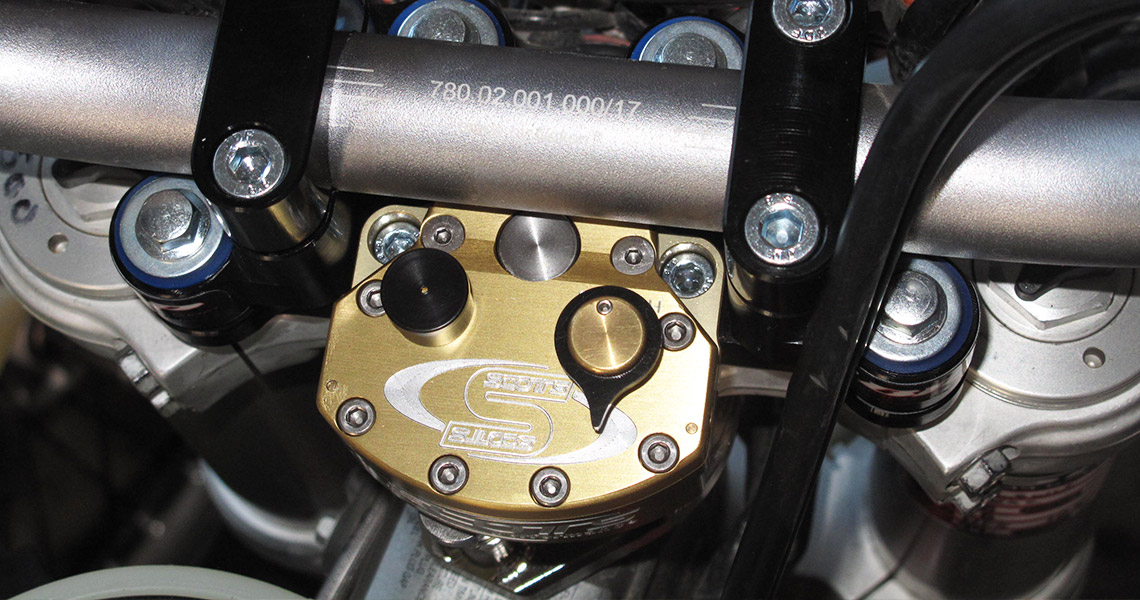


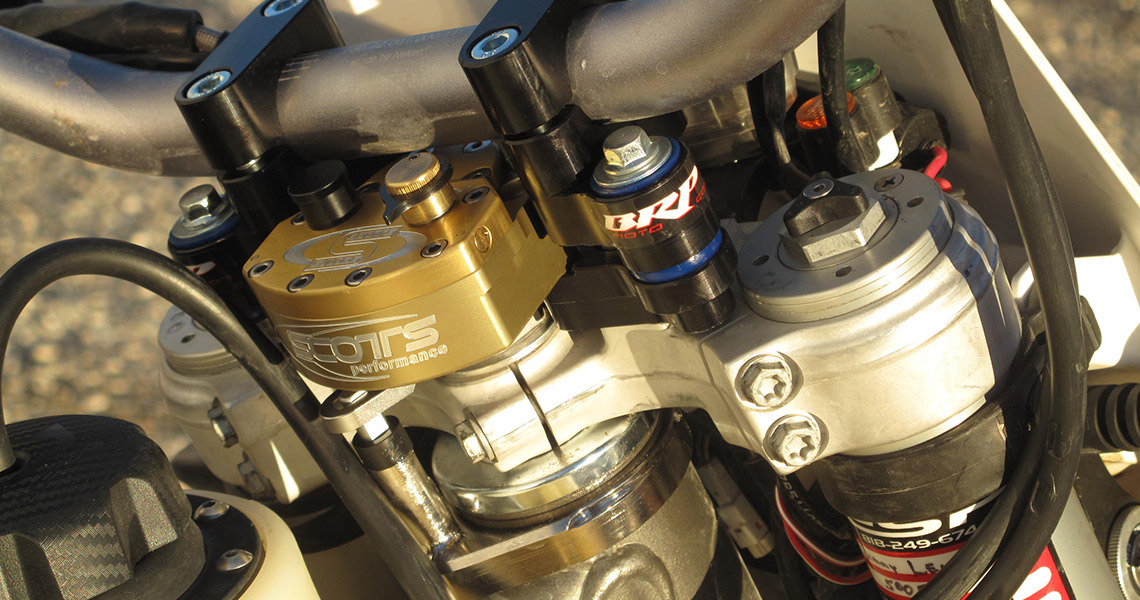

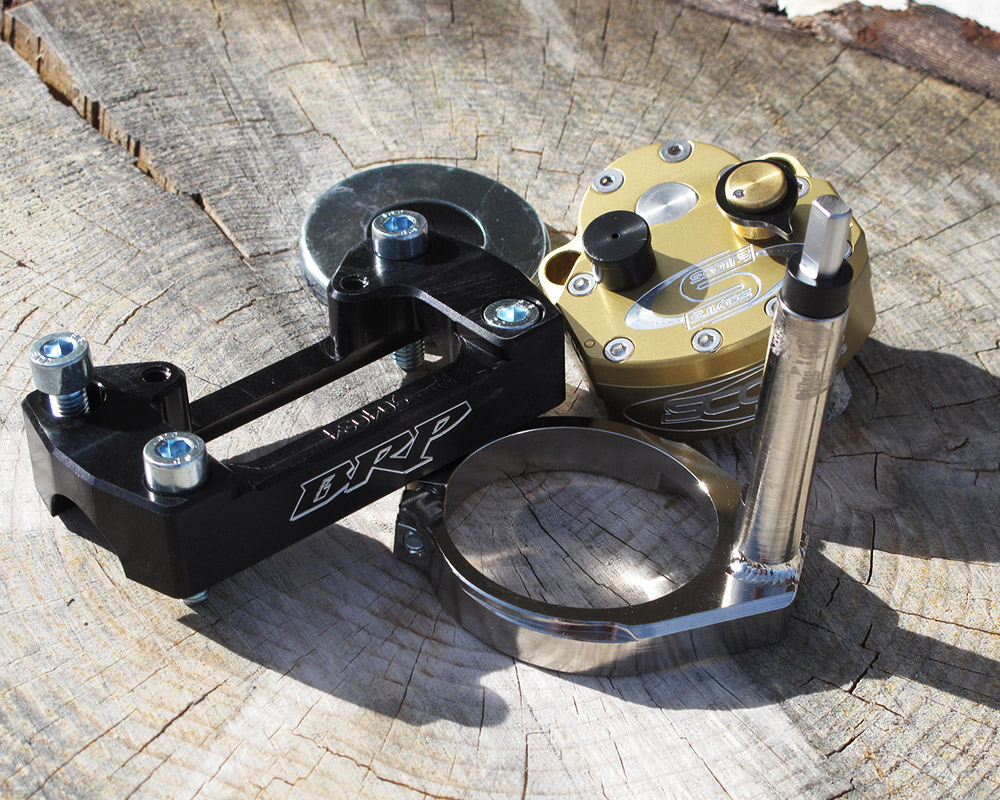

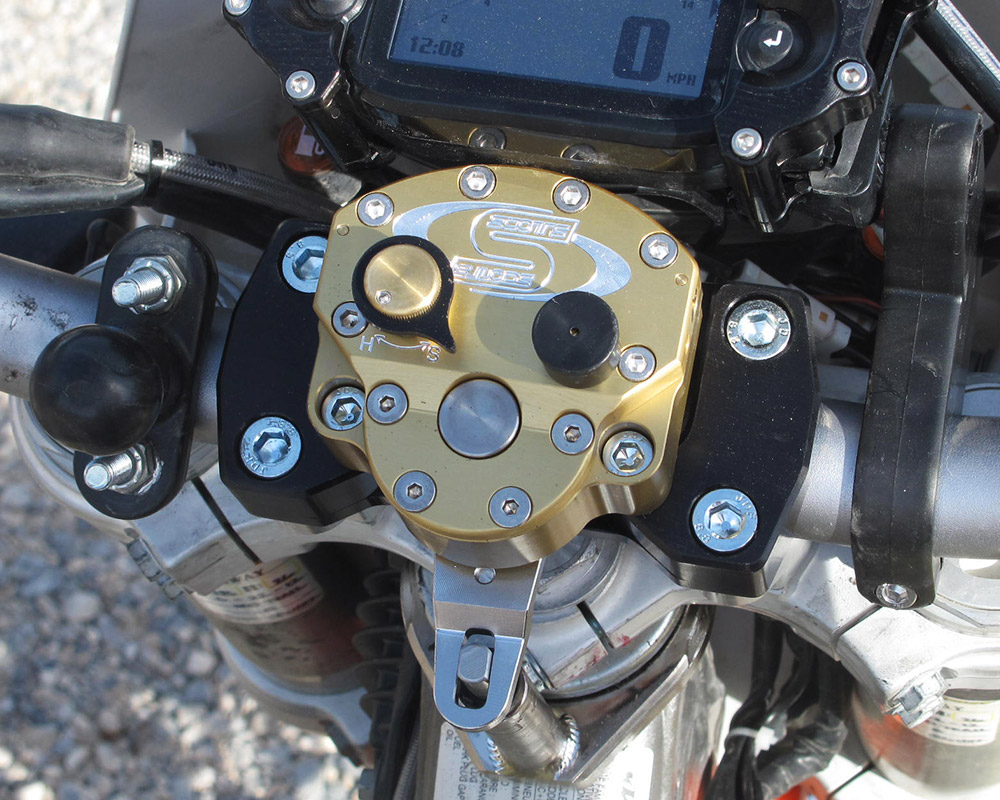

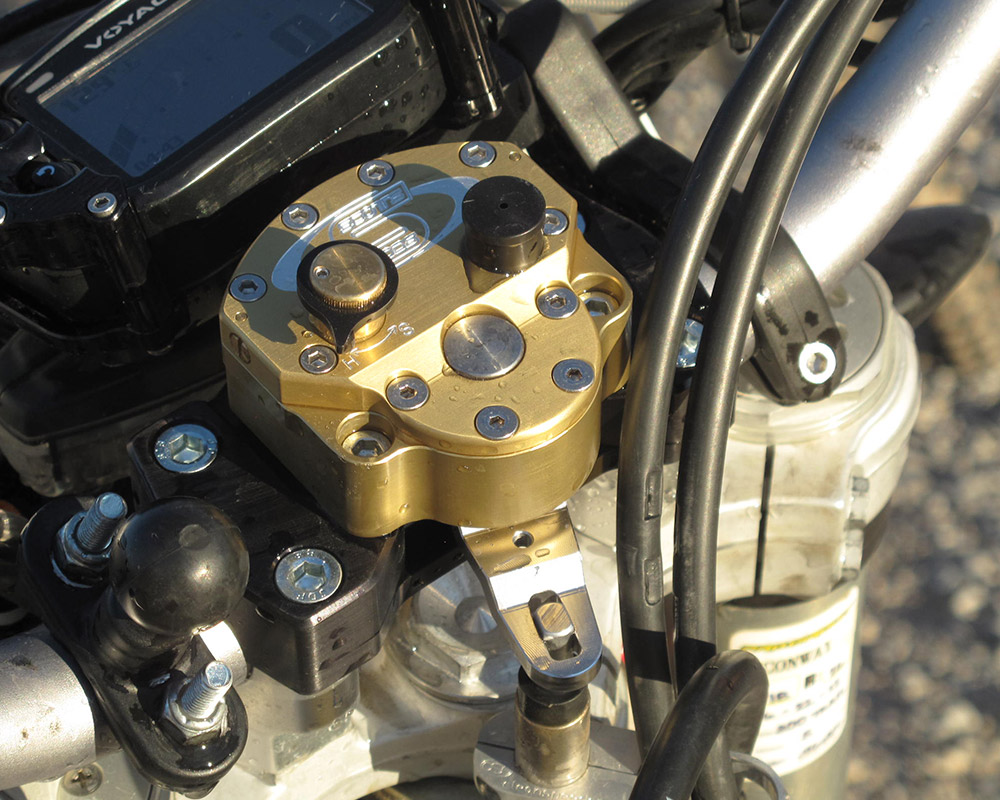

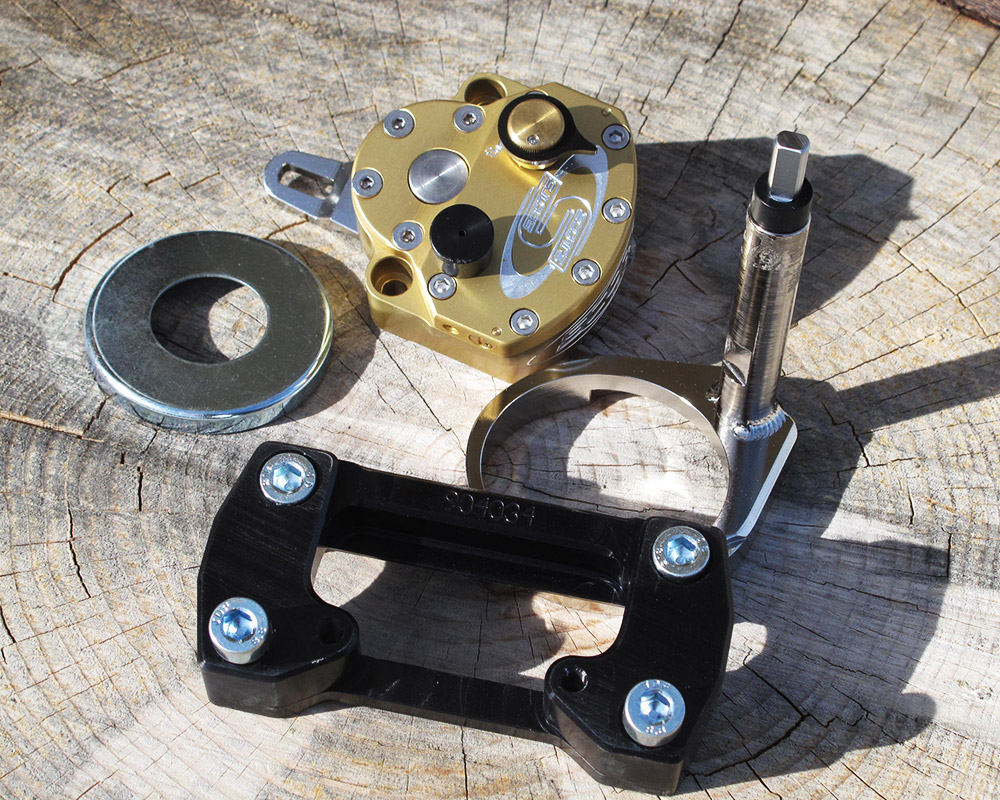
2 Responses to “Scotts Steering Stabilizer”
Jeffrey Irvin
There seems to be two types of steering stabilizers for dirtbikes: those that have return to center damping and those that don’t. Off road is there any benefit to return to center damping?
Which disciplines of off road riding favor a steering stabilizer? It seems like all the desert racers run them but the endurocross and extreme enduro racers don’t. Thanks
Jimmy Lewis
Most prefer the free to center because you do not have to fight the bars back to center and they will naturally center themselves that way. Some of the trials biased riders are so sensitive to balance and the feeling they get through the bars that they don’t like the resistance, any resistance, to then handlebar movement. And a lot of it is just personal preference but most who learn to run light slow-speed damping and tune the high-speed to kick in when it is needed never go back.